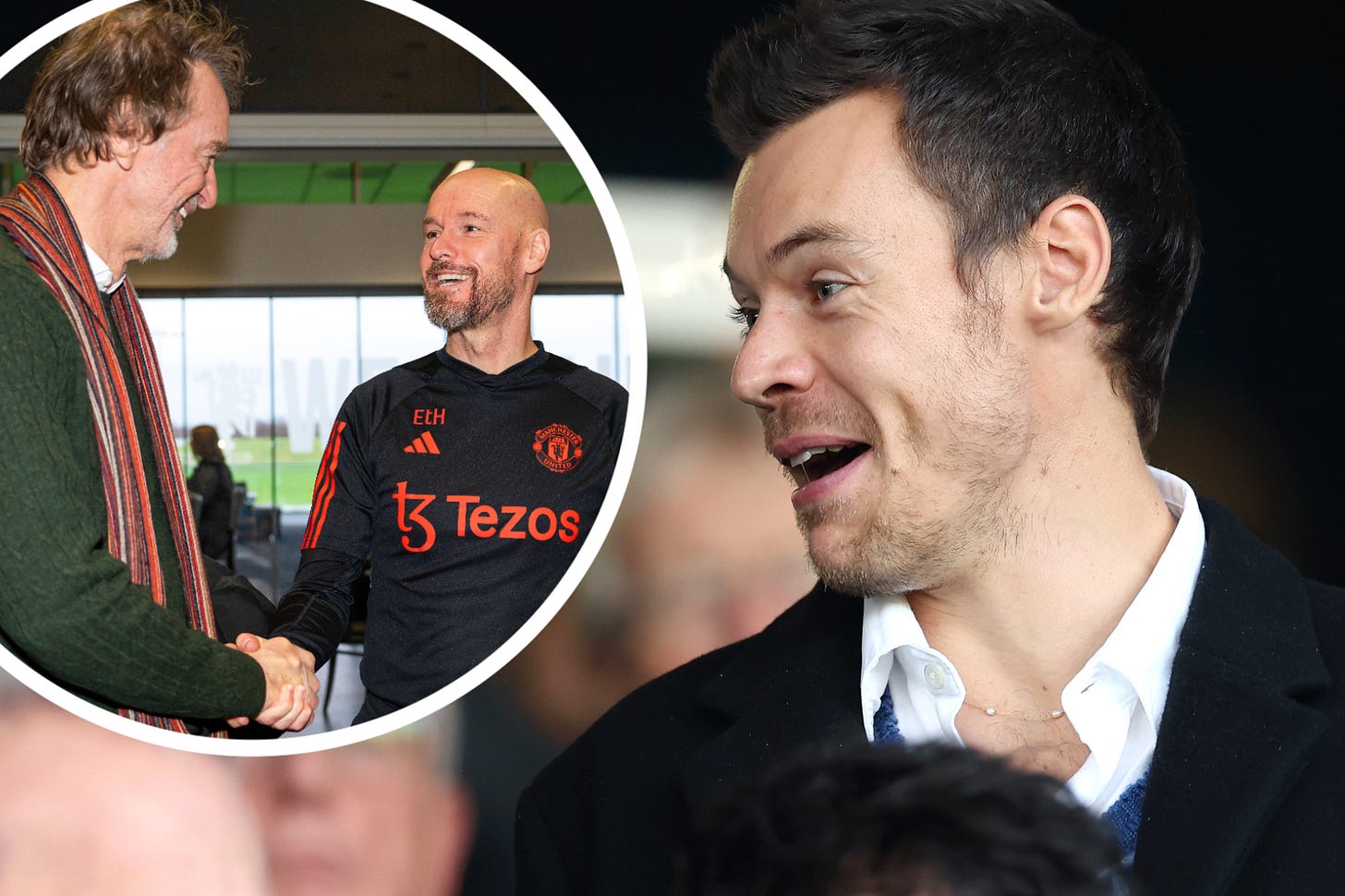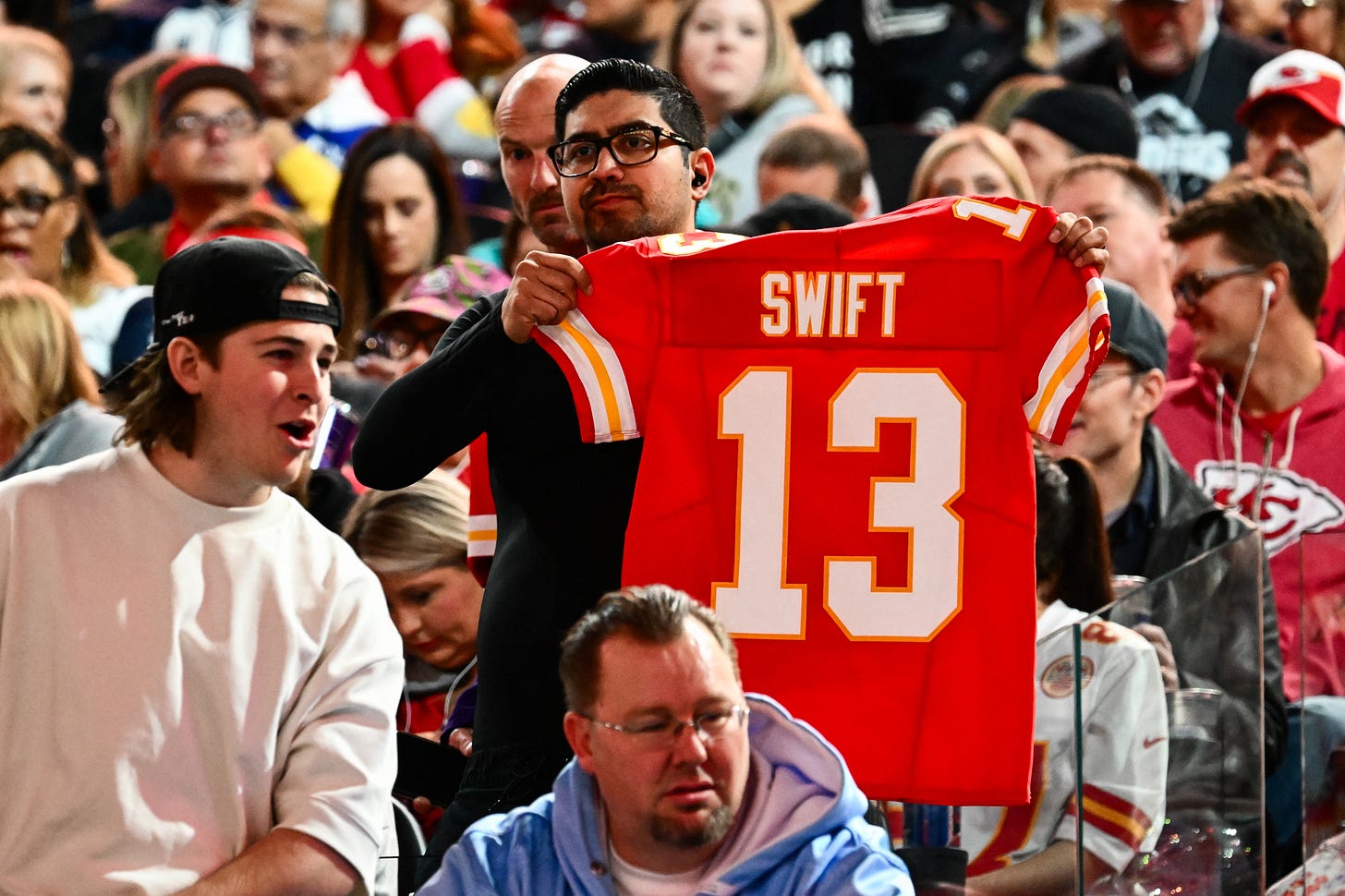It's not the same as it was: How Harry Styles can help Manchester United win big in a new football landscape
How to leverage superstardom of famous supporters will be on the minds of big clubs

Before I start to delve into why major sports teams really need to be trying to find leverage when it comes to their famous fans, this is a short note to say that this edition of The Bottom Line is FREE for all to read.
Every week I look at lifting the rocks of the business of football and seeing what’s underneath, trying to make sense of where the game of football is at, and, crucially, where it is going.
The response I have had so far to The Bottom Line has been great, and thank you to all those who have subscribed. If you feel that the business of football might be something you’d be interested in knowing about in an accessible format, you might consider subscribing to my musings, and those of industry experts I speak to along the way, to know a little more.
You can subscribe HERE. In the meantime, here’s something on Harry Styles and Manchester United.
Man watching his favourite football team isn’t news; Harry Styles watching Manchester United is.
Luton was the unlikeliest of Premier League venues where one of the world’s most famous pop stars would make an impromptu visit, but sitting next to Hatters stalwart Mick Harford at Kenilworth Road last week, the former One Direction singer ended up stealing the headlines.
Before finding fame and fortune through the Simon Cowell music factory that was the X Factor, Styles was a typical teenager, hailing from the quiet, rather leafy village of Holmes Chapel. For many a Cheshire teenager, Manchester United was the pull when it came to selecting which team to support.
Styles is on another level of superstardom, the kind of superstardom that can be hard to understand when looking at pop culture for teens to twenty-somethings through the lens of someone fast approaching 40.
He has adoring fans in their millions, his fame perhaps only eclipsed by the phenomenon that is Taylor Swift. But to understand where I’m going with all of this, Taylor Swift is rather important, for she has opened the eyes and ears of sports team executives around the world, keen to see how a sprinkle of celebrity can help them leverage their position and get more attention.
The Super Bowl was won by the Kansas City Chiefs earlier in February after they defeated the Philadelphia Eagles. Patrick Mahomes etched his name into sporting legend by becoming only the fifth quarterback in NFL history to win three or more Super Bowls. On his current trajectory, he may well find at the end of his career that he is regarded as the greatest to ever play the sport. But enough of that man’s sensational athletic prowess: did you catch Taylor Swift cheering on her beau, Travis Kelce? If you didn’t, you likely heard about it.
As a journalist, I am sent rather random emails on a daily basis about obscure facts and figures that have little to no relevance to where my editorial focus lies. But never have I had so many emails about one person, daily, and the minutiae of detail about every conceivable angle that there could possibly be for Swift attending the Super Bowl.
From how much she could make per Instagram post, to how many followers she accrued during the game, to how she ‘outshone’ the players that actually competed in the NFL’s showpiece event, it was a Super Bowl that will be remembered for Swift, despite the fact that it was thoroughly entertaining fare.
It wasn’t just the Super Bowl, though: this has been a season utterly dominated by the star power that Swift exudes. When she showed up at games, so did the interest. For the Chiefs’ marketing team, she must have been manna from heaven: a goddess sent from the commercial gods to boost revenue-making opportunities; make hay while the sun shines, etc.
Swift’s presence at games during the season, building up to the Super Bowl itself, where ad space is among the highest value in television globally, meant that other companies sensed an opportunity to market their wares to a different audience, one that may not have previously been interested in tuning in to the Super Bowl.
How long the interest may last for the Chiefs is dependent on a number of factors, some of which are out of the team’s control. But there will be an end to it at some stage.
In the case of Styles, it is a little different. He is a Manchester United fan, and following your football team is a cradle-to-the-grave type of deal. You can’t get out of this contract. Ever. I support a football team, Chester, in the sixth tier of English football, and my love passed through the generations. I can’t leave. It’s the football equivalent of Stockholm Syndrome at times - which, funnily enough, is the title of a One Direction song. Anyway, I digress.
While to the traditional football fan the presence of someone like Harry Styles at a United game may seem something of a sideshow, and a little inconsequential, having someone who possesses so much star power - not only in the UK, but in key markets for football club brand growth such as the USA and Asia - is potentially impactful in the longer term.
There will undoubtedly be conversations that have taken place internally around how having Harry Styles as a fan could aid Manchester United’s plan for growth because while it isn’t a new phenomenon (see Elton John at Watford etc.), it is one that is unique given just how popular Styles is, and how he reaches demographics that football clubs just can’t get at.
Monetising fandom sounds like an awful thing to pursue. But in order to spend money on new players, big wages, and plush stadiums, the cost has to be met somewhere along the line, and that has long been the amount of value placed in TV subscriptions for live games. Now, clubs are thinking more outside the box. How do they reach people who may not be football fans but who may have an interest in the brand or the narrative around it? I dare say more Travis Kelce jerseys have been sold in the past six months than at any point in his NFL career.
Football clubs look for lifestyle brand opportunities. That is something that Paris Saint-Germain pursued through linking up with Nike’s Air Jordan sister brand for merchandise, aiming to use the unique fashion pull of Paris to sell merchandise to people who likely don’t tune in to watch the side play Clermont Foot in Ligue 1.
They have a store on New York’s Fifth Avenue, and the club has tried its best to leverage what it has at its disposal, which has over the past five years been its location, Lionel Messi, Neymar Jnr, and Kylian Mbappe. By the end of this season only one to remain will be location, but that still may be enough.
Back in 2010, Liverpool owners Fenway Sports Group (FSG) wanted to land basketball icon LeBron James as a client for its Fenway Sports Management division. Knowing they would face a huge battle for that deal, they decided to offer him equity in Liverpool - 2 per cent to be exact - and that was enough to clinch it.
Since then, James has gone on to establish himself as a basketball legend, only really outshone by Michael Jordan. Over that period of time, he accreted his 2% of Liverpool into 1% of FSG’s £10bn empire, with that percentage having increased in 2022 through a lifetime equity deal.
That, and Liverpool and James’ simpatico relationship that exists with Nike, has seen James boost the Liverpool brand abroad, fronting a leisurewear range bearing his name and the club’s logo, bringing the club’s brand to a new audience. Perhaps something similar could be done with someone like Styles.
An Adidas x Harry Styles combination might not be something to wear down the pub, but for a certain demographic, it might be their way to be active participants, giving them an entry into club merchandise and perhaps in some cases starting a life-long relationship with the club which is of huge value, as football fans tend to be sticky customers.
Styles has already invested in the Manchester scene via his stake in the Co-Op Live Arena that has been built close to Manchester City’s Etihad Stadium, with City’s Abu Dhabi owners providing a significant amount of funding.
With the potential for the redevelopment of Old Trafford on the watch of Sir Jim Ratcliffe, and the vision to create a second ‘national stadium’ in the North through that redevelopment, not to mention the regeneration of the Trafford Wharfside area that has been proposed, maybe Styles might feature in helping that particular plan grow, whether through annual gigs or other means.
The pull of celebrity in football might not sit well with some, but so multifaceted is the game now it is vital for clubs that they latch on to every available opportunity to grow market share, especially in key markets like the US.
The success of the ‘Welcome to Wrexham’ Disney+ documentary has woken some clubs up on that, with the takeover of the North Wales club by Hollywood stars Ryan Reynolds and Rob McElhenney having proven a commercial success and a competitive one for the Red Dragons, who had been the longest serving members of Non-League football’s top tier, the National League, until their escape last season.
The race to be the best becomes more costly every single season. It is a cost that has to be met, and while that has been able to be done through exponential growth of media rights at home and abroad, that music is starting to show signs of slowing. While the next international deal will be bigger than the last, the domestic deal has shown some signs of stagnation, the £6.7bn headline figure somewhat skewed by the additional year’s cycle, as well as the giving away of more inventory (70 games more per season) in order to get the sums they craved.
Clubs need to diversify revenue streams and become less reliant on broadcast, and that makes the race for hearts and minds in countries like the US crucial to opening up more commercial revenue opportunities.
Having Harry Styles might not be so bad for Manchester United to cut through the noise in a new landscape for football. After all, you know it's not the same as it was.





